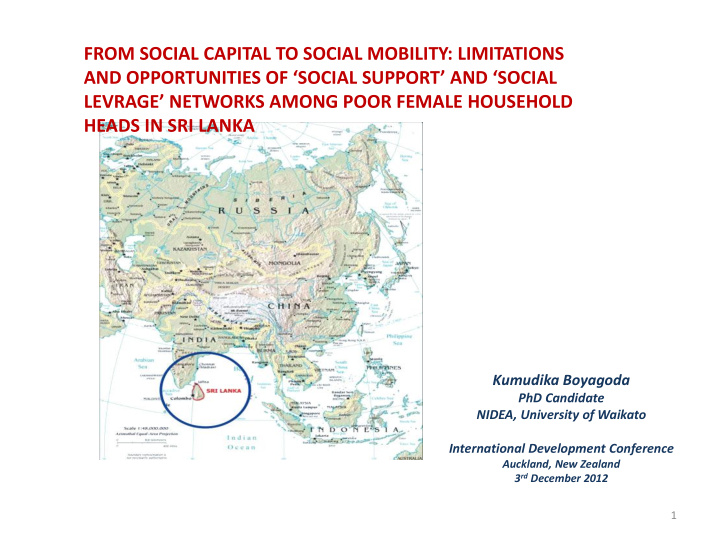



FROM SOCIAL CAPITAL TO SOCIAL MOBILITY: LIMITATIONS AND OPPORTUNITIES OF ‘SOCIAL SUPPORT’ AND ‘SOCIAL LEVRAGE’ NETWORKS AMONG POOR FEMALE HOUSEHOLD HEADS IN SRI LANKA Kumudika Boyagoda PhD Candidate NIDEA, University of Waikato International Development Conference Auckland, New Zealand 3 rd December 2012 1
INTRODUCTION Social Capital (SC) refers to personal connections & interpersonal interactions- social networks Non monetary resource/accessible to all Major or only asset possessed by the poor Powerful term to analyse and alleviate poverty Major focus on increasing SC that poor posses 2
RATIONALE & RESEARCH QUESTION Social Capital is not a unitary concept Different forms / Different uses • What type of SC does the poor have ? • Can one type of SC substitute for another ? 3
Brigg’s (1998) distinction of SC Social Support Social Leverage • Kin/Neighbours/friends • People unlike self • Homogeneous nature • Dispersed & • Strong ties heterogeneous • Cope with everyday • Weak ties demands • Upward mobility Food/childcare/emotional Education/training/new support/small loans information Helps ‘GET AHEAD’ Helps to ‘GET BY’ 4
OBJECTIVE Analyse social networks of female heads of HH DATA Quantitative and Qualitative data from female heads of households in three districts of Sri Lanka 5
RESULTS Distribution of female heads by type of SC 52% % from total 48% Only support Support & leverage Type of network 6
RESULTS cont. Social capital by income level 90% 80% 80% 70% 71% % from total 60% 56% 50% only support 40% 44% Support+leverage 30% 29% 20% 20% 10% 0% Low Middle High Income level 7
RESULTS cont. Social capital by education 120% 100% 100% % from total 80% 72% 68% 60% Only support 55% Support+leverage 40% 45% 32% 28% 20% 0% 0% No sch./primary Secondary Tertiary Diploma/degree Education level 8
RESULTS cont . Low income women with only social support “… people in the neighbourhood are extremely helpful …not that they have… they are also poor …but they try to give the kids something to eat when there is no food at home” (Estate sector/married - spouse paralysed/3 dependent children) “When I became homeless…village youth built this hut for us… it is state land…we are encroachers…this is not a house…but we have a place to sleep…they did what they can” (Rural sector/widowed/2 dependent children) “When husband becomes a devil … neighbours hide us …because she knows that she got me married to a mad man, mother-in-law feeds the children …but I want him behind bars …or take him to the ‘mad house’ (hospital for the mentally sick) in Colombo…and go to Middle East… mother in law thinks ‘children are fed what else do you want” (Urban/married to mentally sick man/3 dependent children) 9
RESULTS cont . Women showing upward socio economic mobility “ Madam was good to me…she taught me to make cakes and sew …she didn’t allow me to buy unnecessary things… adviced me to collect money and buy sewing machines …when I returned from Middle East…I brought three sewing machines…and started my business here…” (Started as domestic helper in the Middle East /now high income business woman) Because I didn’t lie and steal, ladies & gentlemen in the houses I worked liked me. One of them got me a permanent job as office cleaner…my bosses arranged a housing loan to be deducted little by little from the salary…because I had a stable salary I educated my daughter …they send the salary to the bank, so my husband can’t take it…” (Lived in a shanty/started as domestic helper / now in stable employment/daughter in clerical post/owns a small house/middle income family) 10
CONCLUSIONS Poor are more likely to have only social support Source of strength for subsistence needs Lacks quality/and permanent solutions because networks them selves are poor Poverty alleviations should focus more on quality and diversity of SC than quantity 11
Thank you! Kumudika Boyagoda 12
Recommend
More recommend